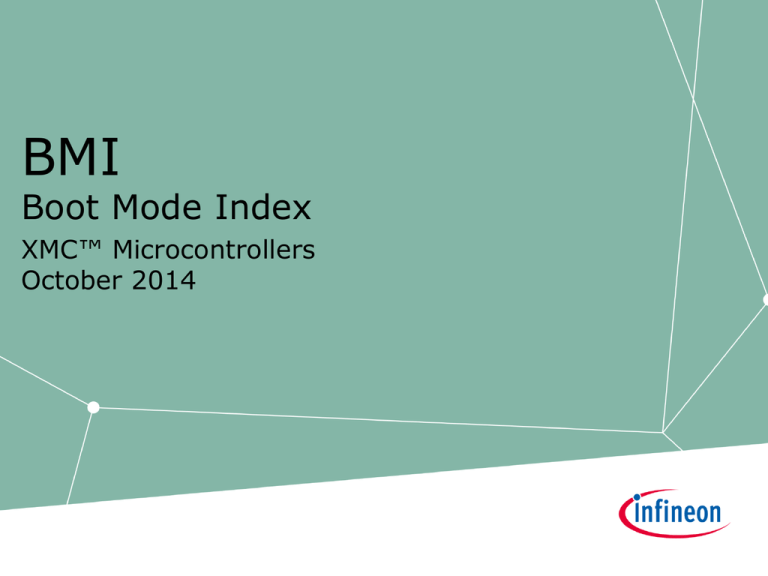
BMI
Boot Mode Index
XMC™ Microcontrollers
October 2014
%
ET
BMI
Boot Mode Index
Boot Mode Index (BMI) of XMC1000 Family
Highlights
Boot Mode Index
ASC_BSL
The BMI value determines the start-up
mode and debug configuration of the
XMC1000. Bootstrap modes via UART or
SPI as well as single pin debug or SWD
are supported. Setting the BMI to "User
productive Mode" disables all interfaces
to safeguard the XMC1000 against
external accesses.
SSC_BSL
User mode HAR
(SWD/SPD)
User mode debug
(SWD/SPD)
User productive Mode
50%
Key Feature
ASC_BSL
Wait for ASC_BSL commands
1
If no BSL command received before time-out
period expired, run user code (Flash)
› Start-up mode selection requires
no pins
Wait for SSC_BSL commands
SSC_BSL
SSW read BMI
value in Flash
configuration
sector 0
1
If no BSL command received before time-out
period expired, run user code (Flash)
1) for BSL with time-out mode
› More pins available for customer
application usage
Wait for SPD/SWD commands
User mode HAR (SWD/
SPD)
› BMI change supported by ROM
routine
d:
= Start-up Software
Asynchronous Serial Channel
Halt After Reset
Bootstrap Loader mode
Synchronous serial communication
Single Pin Debug
= Serial Wire Debug
Customer Benefits
User mode debug (SWD/
SPD)
run user code (Flash)
(DEBUG access enabled)
User productive Mode
run user code (Flash)
(DEBUG access disabled)
› Easy change of BMI through
customer application code
Copyright © Infineon Technologies AG 2015. All rights reserved.
2
User mode HAR
(SWD/SPD)
BMI
User Requires
mode debug No Pins
Start-up Mode Selection
(SWD/SPD)
› The start-up mode depends
on theMode
value of the BMI value stored
User productive
in the internal flash; no pin for selection is required
100%
50%
› Factory
default start-up mode is the UART Bootstrap Loader
(ASC_BSL)
Wait for ASC_BSL commands
ASC_BSL
1
If no BSL command received before time-out
period expired, run user code (Flash)
Wait for SSC_BSL commands
SSC_BSL
RESET
1
If no BSL command received before time-out
period expired, run user code (Flash)
Wait for SPD/SWD commands
SSW read BMI
value in Flash
configuration
sector 0
User mode HAR (SWD/
SPD)
Legend:
SSW = Start-up Software
ASC = Asynchronous Serial Channel
HAR = Halt After Reset
BSL = Bootstrap Loader mode
SSC = Synchronous serial communication
SPD = Single Pin Debug
SWD = Serial Wire Debug
User mode debug (SWD/
SPD)
run user code (Flash)
(DEBUG access enabled)
User productive Mode
run user code (Flash)
(DEBUG access disabled)
Note: 1) for BSL with time-out mode
Copyright © Infineon Technologies AG 2015. All rights reserved.
3
BMI
BMI Change Supported By ROM Routine
› BMI programing is supported by a ROM routine located at
0x00000108 and can be accessed in the following way:
#define _BmiInstallationReq (0x00000108)
#define XMC1000_BmiInstallationReq (*((unsigned long (**)
(unsigned short)) _BmiInstallationReq))
XMC1000_BmiInstallationReq(0xFFC0); // BMI = ASC_BSL
Start-up Mode
Pins used
BMI value
ASC Bootstrap Load Mode
(ASC_BSL)
User Mode (Productive)
P0.14/P0.15
P1.3/P1.2
-
or 0xFFC0
User Mode (Debug) SWD0 P0.14/P0.15
0xF8C3
User Mode (Debug) SWD1 P1.3/P1.2
0xFAC3
User Mode (Debug) SPD0
P0.14
0xF9C3
User Mode (Debug) SPD1
P1.3
0xFBC3
User Mode (HAR) SWD0
P0.14/P0.15
0xF8C7
User Mode (HAR) SWD1
P1.3/P1.2
0xFAC7
User Mode (HAR) SPD0
P0.14
0xF9C7
User Mode (HAR) SPD1
P1.3
0xFBC7
0xF8C1
Copyright © Infineon Technologies AG 2015. All rights reserved.
4
BMI
System Integration
XMC1100
ROM routine
Communication
XMC1000_BmiInstallationReq(BMI)
●
XMC1300
●
call
write
Application
Code
FLASH
BMI Register
›
●
XMC1200
– Motor Control
– Intelligent Lighting
– Power Conversion
– Human Machine Interface
– Connectivity
– General Purpose
During mass production stage, the
device will most probably programmed
to “Productive mode” for flash protection
of the application code.
For field update of the flash content the
“Productive mode” can be changed back
to another start-up mode by the
application code at any time.
Target applications
– Touch Sense
GPIO, Interrupt
E.g. the application code could provide a
feature for changing the BMI back to
ASC_BSL mode when receiving a special
command via UART or triggered by an
external signal via a GPIO pin.
Copyright © Infineon Technologies AG 2015. All rights reserved.
5
Application Examples
Use Cases of the Start-up Modes
Start-up Mode
Use Case
› Bootstrap Loader mode (ASC_BSL,
SSC_BSL)
› Allows easy and quick programming
/ erasing of the flash by code
downloaded into the SRAM via UART
or SPI.
› The user code is executed after
power-up. A debugger can connect
to the device at any time via SWD or
SPD:
› SWD is a standard debug protocol
for ARM® Cortex™ microcontrollers.
› SPD is Infineon propriety debug
protocol allowing Single Pin Debug.
› User code execution in flash must be
started by the debugger.
› Flash protection scheme. Debugger
cannot connect to device and access
the Flash content.
› User mode with debug enabled
(UMD)
› User mode with debug enabled
and Halt After Reset (UMHAR)
› User productive mode (UPM)
Copyright © Infineon Technologies AG 2015. All rights reserved.
6
BMI
Table of contents
1
Programming and Debugging Pin
2
User Productive Mode
3
Using DAVE™ to program BMI value
4
Additional note on programming the BMI value
Copyright © Infineon Technologies AG 2015. All rights reserved.
7
BMI
Programming and Debugging Pin
›
Two sets of pins available for programming and debugging :
– Channel 0 supports all start-up modes including SSC_SCL
– Channel 1 supports full and half duplex ASC_BSL, SWD
and SPD
ASC_BSL User Mode User Mode
(Full duplex) SWD0/1
SPD0/1
P0.13
Channel 0 P0.14
XMC1000
P0.15
Channel 1
P1.3
P1.2
ASC_BSL
(Half duplex)
SSC_BSL
-
-
-
-
RXD
SWDIO
SPD
RxD-TxD(Half duplex)
SCLK
TXD
SWDCLK
-
-
MRST-MTSR
RXD
SWDIO
SPD
RxD-TxD(Half duplex)
TXD
SWDCLK
-
-
Copyright © Infineon Technologies AG 2015. All rights reserved.
/CS
8
BMI
User Productive Mode (1/2)
›
BMI=0xF8C1
›
This mode should be used only if the user has confirmed that
the code is FULLY TESTED and NO MORE MODIFICATION
of code is required.
›
After changing to “User Productive Mode” and a new power-up
the user code will start to run at the address contained at the
flash location 0x10001004.
›
“User Productive Mode” provides indirectly MEMORY
PROTECTION by not allowing external tools e.g. debugger and
Flash Programming Tools to access (read/write) the device.
Copyright © Infineon Technologies AG 2015. All rights reserved.
9
BMI
User Productive Mode (2/2)
›
There is no external access to the device once it is
programmed to “User Productive Mode”, unless there is a
specific routine already embedded in user code.
›
This specific routine has to be called under user-defined
conditions, e.g. via interrupt or GPIO pins latch values.
›
The specific routine calls the
XMC1000_BmiInstallationReq(new BMI) routine to reprogram a new BMI value.
›
For code protection purpose, changing from “User
Productive Mode” and any other mode, the start-up software
will erase the full flash of the device and re-install the default
BMI -> ASC_BSL (UART-BSL). Hence, user needs to call the
BMI re-programming routine again via the UART-BSL mode if
that is not the desired start-up mode.
Copyright © Infineon Technologies AG 2015. All rights reserved.
10
BMI
Using DAVETM to program BMI value
›
From DAVETM v3.1.8 onward, there is a BMI handling utility
for user to read the BMI and set the BMI of XMC1000 device.
›
This BMI handling utility only work with XMC1000 Boot Kit.
Copyright © Infineon Technologies AG 2015. All rights reserved.
11
BMI
Additional note on programming the BMI value
›
The default boot mode for XMC1000 device is UART-BSL mode.
›
A master reset will be executed after BMI value is updated.
Switching off the supply voltage before Master reset happen
will cause the BMI value to change to default BMI -> ASC_BSL.
›
The VDDP should keep stable at operating voltage of XMC1000
during the programming of BMI value. The time taken from
calling the XMC1000_BmiInstallationReq(new BMI) routine till
the BMI value is changed after the master reset, is about
10msec @ MCLK 8MHz.
Copyright © Infineon Technologies AG 2015. All rights reserved.
12
Support material:
Collaterals and
Brochures
›
›
›
›
›
Product Briefs
Selection Guides
Application Brochures
Presentations
Press Releases, Ads
›
www.infineon.com/XMC
Technical Material
›
›
›
›
›
Application Notes
Technical Articles
Simulation Models
Datasheets, MCDS Files
PCB Design Data
›
›
›
›
www.infineon.com/XMC
Kits and Boards
DAVETM
Software and Tool Ecosystem
Videos
› Technical Videos
› Product Information
Videos
› Infineon Media Center
› XMC Mediathek
Contact
› Forums
› Product Support
› Infineon Forums
› Technical Assistance Center (TAC)
Copyright © Infineon Technologies AG 2016. All rights reserved.
13
Disclaimer
The information given in this training materials is given as a hint for
the implementation of the Infineon Technologies component only and
shall not be regarded as any description or warranty of a certain
functionality, condition or quality of the Infineon Technologies
component.
Infineon Technologies hereby disclaims any and all warranties and
liabilities of any kind (including without limitation warranties of noninfringement of intellectual property rights of any third party) with
respect to any and all information given in this training material.
All the images used in the trainings are free for commercial use or
free for use with attribution and were designed by Freepik.



